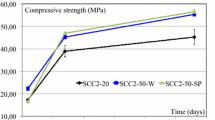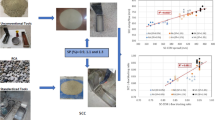Abstract
An experimental program was undertaken to investigate the homogeneity of in situ properties of wall elements cast with various commercially available self-consolidating concrete (SCC) mixtures. Wall elements measuring 5 m in length, 1.6 m in height, and 0.35 m in width were cast. The SCC mixtures were proportioned with various binders and admixtures and had different levels of slump flow consistency and design compressive strengths. The SCC mixtures exhibited adequate passing ability with L-box blocking ratio higher than 0.70 and filling capacity greater than 80%. All cast walls exhibited homogeneous in situ mechanical properties, regardless of the core location. The coefficient of variation (COV) of in situ compressive strength values ranged from 3 to 6%. Conventional vibrated concrete used to cast a reference wall element led to relatively large spread in in situ rapid chloride-ion permeability values and high COV of spacing factor compared to those of the various SCC wall elements (17% vs. 6–12%). Good correlation was established between surface settlement and top-bar factor of reinforcing bars embedded along the various heights of the 1.6-m high walls. On average, concrete with 0.50% surface settlement was shown to exhibit a maximum top-bar factor of 1.4. The mean top-bar factor values near the top of walls cast with SCC were limited to 1.4, which is considered a low value given the high slump flow of the concrete and the depth of cast elements.











Similar content being viewed by others
References
Khayat KH, Manai L, Trudel A (1997) In situ mechanical properties of wall elements cast using self-consolidating concrete. ACI Mater J 94(6):491–500
ACI Committee 214 (2008) Guide for obtaining cores and interpreting compressive strength results. ACI 214.4R-03, ACI manual of concrete practice
Sonebi M, Rooney M, Bartos PJM (2002) In situ compressive strength of self-compacting concrete. Concrete 36(3):48–49
Petrov N, Khayat KH, Tagnit-Hamou A (2001) Effect of stability of self-consolidating concrete on the distribution of steel corrosion characteristics along experimental wall elements. In: Proceedings of the 2nd international symposium on self-compacting concrete, Japan, pp 441–450
Sonebi M, Bartos PJM (1999) Hardened SCC and its bond with reinforcement. In: Proceedings of the 1st RILEM international symposium on self-compacting concrete, Stockholm, Sweden, pp 275–289
Gibbs JC, Zhu W (1999) Strength of hardened self-compacting concrete. In: Proceedings of the 1st RILEM international symposium on self-compacting concrete, Stockholm, Sweden, pp 199–209
Attiogbe EK, See HT, Daczko JA (2002) Engineering properties of self-consolidating concrete. In: Proceedings of the 1st North American conference on the design and use of SCC, Chicago, IL, USA, pp 371–376
Holschemacher K, Klug Y (2002) A database for the evaluation of hardened properties of SCC. Leipzig Annual Civil Engineering Report No. 7, Universität Leipzig, pp 123–134
Hegger J, Gortz SG, Kommer B, Tiggs C, Dross C (2003) Prestressed precast beams made of self-compacting concrete. Betonwerk + Fertigteil-Technik (Concrete Plant + Precast Technology), pp 40–46
Koning G, Holschemacher K, Dehn F, Weiβe D (2001) Self-compacting concrete-time development of materials properties and bond behaviour. In: Proceedings of the 2nd international symposium on self-compacting concrete, Tokyo, Japan, pp 507–516
Khayat KH, Attiogbe EK, See HT (2007) Effect of admixture combinations on top-bar effect of highly flowable and self-consolidating concrete mixtures. ACI-SP 247-3, Special publications, pp 33–44
Hwang S-D, Khayat KH, Bonneau O, Mayen-Reyna D (2004) Workability requirements of self-consolidating concrete used in casting highly restricted structural sections. In: Proceedings of the 4th international conference on concrete under severe conditions (CONSEC 04), Seoul, Korea, pp 1321–1328
Hwang S-D, Bonneau O, Khayat KH (2006) Performance-based specifications of self-consolidating concrete used in structural applications. ACI Mater J 103(2):121–129
Hwang S-D, Khayat KH (2008) Effect of mixture composition on restrained shrinkage cracking of self-consolidating concrete used in repair. ACI Mater J 105(5):498–508
Hwang S-D, Khayat KH (2009) Effect of mix design on restrained shrinkage of self-consolidating concrete. Mater Struct 43(3):367–380
Khayat KH (1998) Use of viscosity-modifying admixture to reduce top-bar effect of anchored bars cast with fluid concrete. ACI Mater J 95(2):158–167
Jirsa JO, Breen JE (1981) Influence of casting position and shear on development and splice length—design recommendations. Research Report 242-3F, Center for Transportation Research, University of Texas, USA
Acknowledgments
The authors wish to thank the Natural Sciences and Engineering Research Council of Canada (NSERC) as well as the industrial partners participating in the NSERC-Industry Coop project aimed at developing high-performance SCC for repair applications: Axim, BASF, Chryso, Ciment Québec, City of Montréal, Euclid Canada, Handy Chemicals, Lafarge Canada, Québec Ministry of Transport, St. Lawrence Cement, and W.R. Grace. The assistance of Dr. Olivier Bonneau and Mr. Boualem Abdi in conducting the experimental work is greatly appreciated.
Author information
Authors and Affiliations
Corresponding author
Rights and permissions
About this article
Cite this article
Hwang, SD., Khayat, K.H. Comparison of in situ properties of wall elements cast using self-consolidating concrete. Mater Struct 45, 123–141 (2012). https://doi.org/10.1617/s11527-011-9755-4
Received:
Accepted:
Published:
Issue Date:
DOI: https://doi.org/10.1617/s11527-011-9755-4




